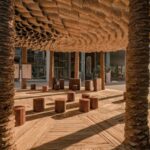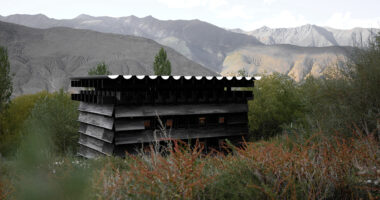Introduction
In Dubai, United Arab Emirates, MULA Design Studio has unveiled the ‘Of Palm’ Pavilion, a temporary installation that celebrates sustainability and the rich heritage of Emirati culture. Lead architect Abdalla Almulla spearheaded this project, which explores innovative uses of the date palm, a symbol deeply rooted in Emirati traditions.

Rediscovering Tradition
The pavilion pays homage to the palm tree’s multifaceted role in Emirati culture, serving as a vital resource for construction and crafts. By delving into age-old practices and material experimentation, the architects sought to reimagine traditional uses of the palm tree, infusing them with contemporary functionality and aesthetics.

Design Concept
‘Of Palm’ Pavilion features a cylindrical porous structure, inviting visitors to engage with different forms of the palm tree. The base, columns, and roof are crafted from various components of the palm tree, including palm wood, trunk, and khoos mat—a traditional Emirati product made from palm leaves. The radial arrangement of columns mirrors the architectural style of traditional Emirati huts, symbolizing a harmonious blend of heritage and innovation.


Innovative Construction Techniques
The roof of the pavilion showcases innovative construction techniques, combining traditional palm weaving with parametric design principles. By experimenting with folding techniques and modular assembly, the architects achieved a conical roof structure that embodies both intricacy and efficiency. This marriage of tradition and innovation demonstrates a deep understanding of Emirati craftsmanship and its potential for contemporary application.

Repurposing Tradition for Modernity
‘Of Palm’ Pavilion exemplifies the ethos of repurposing traditional sustainable practices for the modern world. By breathing new life into age-old traditions, the pavilion symbolizes hope for a more sustainable future. Through thoughtful design and material experimentation, MULA Design Studio has created a space that not only honors Emirati heritage but also inspires dialogue and reflection on the importance of sustainability in architecture and culture.

Conclusion
As a testament to the resilience and ingenuity of Emirati culture, the ‘Of Palm’ Pavilion stands as a beacon of sustainability and innovation in Dubai. By harnessing the timeless wisdom of traditional craftsmanship and the abundance of natural resources, this temporary installation offers a glimpse into a future where heritage and modernity coexist in harmony.


















